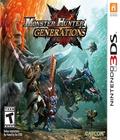Pre-order Monster Hunter Generations
Monster Hunter is one of those franchises that can seem a bit impenetrable. Without actual hands-on time, the gameplay and mechanics can look distinctly alien and confusing, especially when you see a battle against a huge enemy where players are laying traps, baiting attacks and trying to break certain body parts. It's also understandable that getting into the franchise can be tough since there are countless revisions, re-releases and sequels that make it difficult to tell where to start. Capcom is well aware of this intimidating factor, which is why Monster Hunter Generations (known as Monster Hunter Cross in Japan) is designed to be a great starting point in the hunting-action genre.
Monster Hunter Generations isn't a sequel so much as it is a "greatest hits" collection of Monster Hunter. It contains locations and monsters from all the previous Monster Hunter titles, though it also has its own handful of new creatures and gameplay mechanics. The core system is built on the Monster Hunter 4 engine, and on the surface, the game has a lot of similarities with Monster Hunter 4 Ultimate. Anyone who played MH4 will find a lot familiar here, though we're told the overall structure of the game is designed to make it a newcomer-friendly experience. There are some significant additions that also drastically mix it up.
One of the big new features in Monster Hunter Generations is the addition of Styles, which are slightly reminiscent of Devil May Cry's similarly named Style system. There are four styles, and all styles work for all gameplay modes: Adept, Aerial, Guild and Striker, each focusing on a different aspect of the combat system. Adept is intended for hardcore of the hardcore. It allows players to make powerful counterattacks during enemy attack windows, effectively offering a high-risk, high-reward play style. Aerial changes your dodge roll into a jump, making it far easier to mount monsters and make aerial attacks at a cost to your ability to dodge. Guild effectively is the default style and plays very similarly to Monster Hunter 4. Striker focuses on the Hunter Arts and is designed to be a heavily offensive style.
While Monster Hunter Generations doesn't feature any new weapon types in the traditional sense, it does in a more unusual sense. Prowler is a new option, where players take control over the series' iconic Felyne race. With our hands-on time with the Prowlers, I got the impression they're meant as a character for newcomers to play alongside their high-leveled friends. The Prowler is smaller and more difficult to hit, has extra lives compared to regular players, and has a skill set based around buffing and supporting allies while building up resources. It's a simpler experience that should be fun for less-hardcore players.
At the end of the day, Monster Hunter Generations is more Monster Hunter. There are no huge changes to the formula, but there are refinements, small additions, and a few interesting mechanical twists that mean even familiar monsters can be defeated in new ways. Monster Hunter Generations will be playable on both the regular and New 3DSes, though as with the previous game, it will have some minor improvements when played on the New 3DS, mostly in terms of texture quality and loading time. Monster Hunter Generations is due out July 15, 2016, exclusively for the 3DS, and a demo is coming soon.
More articles about Monster Hunter Generations











 Marking the 10th Anniversary of the series, Monster Hunter Generations is a new action RPG title that offers up fresh possibilities for hunting.
Marking the 10th Anniversary of the series, Monster Hunter Generations is a new action RPG title that offers up fresh possibilities for hunting.






















